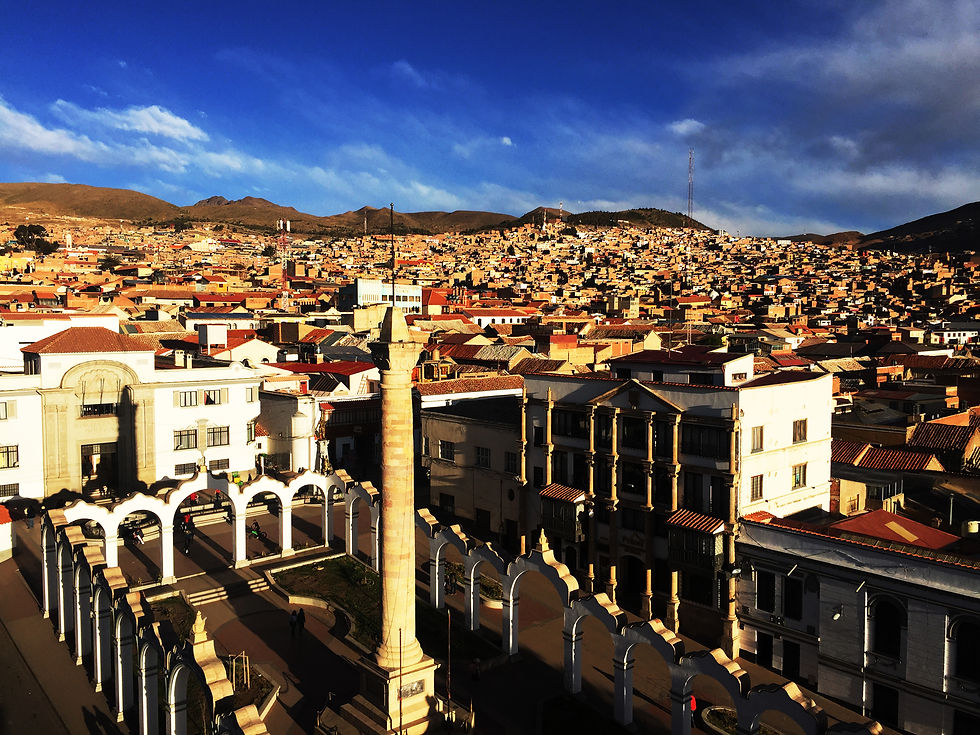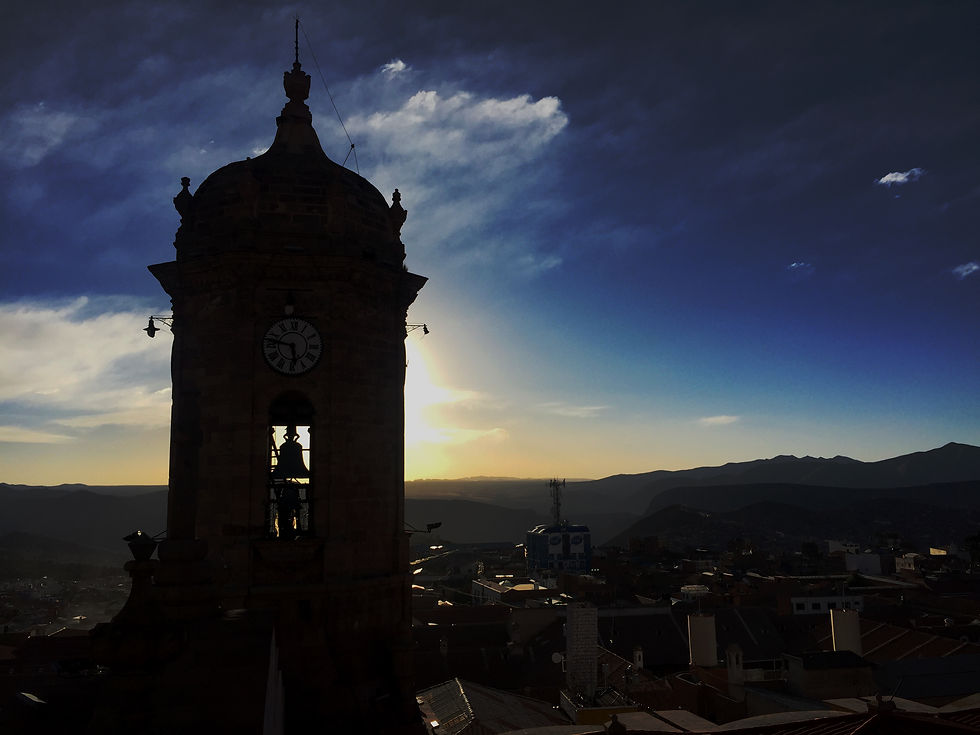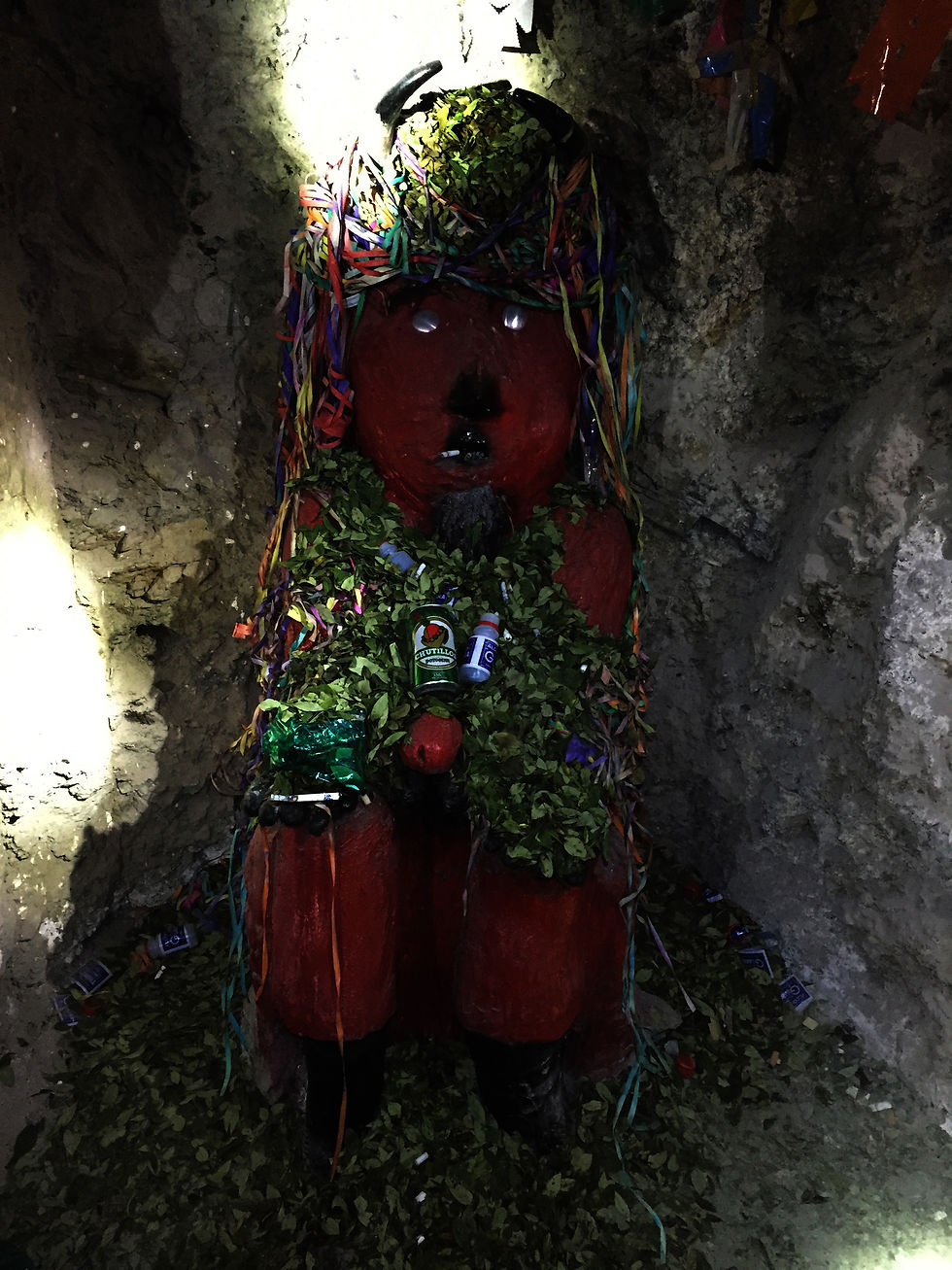Potosi - forgotten El Dorado
- Karolina
- Oct 25, 2017
- 5 min read
"Potosi - the saddest and the most beautiful place you have ever experienced" - this is how Potosi city is described in my travel book - and before I arrived there, I kept wondering: how, why, really, can not be ... and by the time we had to leave and continue travelling , I was so emotional and deeply touched by the history and destiny of this city, that I can definitely agree- it is the saddest and most beautiful place that I have ever seen. The city of Potosi somehow reflects the destiny of the whole country, and, through its peculiar prism, it captures highly concentrated, tragic and spectacularly beautiful image. The history of the city is inseparable from the Silver Mountain or Cerro Rico- the largest source of wealth during the Spanish Empire times. The legend says that the king of the Inca lost his llama, and when he searched for her, he decided to spend the night in the mountain. When he made fire to warm up, he saw a glittering flash-melting silver. Later, at the beginning of the 16th century, the Spanish conquerors, searching for El Dorado, discovered Potosi and made it the first capitalist city in the world. This mountain, with its inexhaustible silver resources, has made Potosi the largest and richest city in South America, the world's largest silver mint. Over the time, silver resources have been decreasing and the city has lost its status and influence. Today, unfortunately, Potosi is a forgotten and very poor place. The saddest part of the story is that millions of local indigenous people and slaves from Africa who have worked in the silver mines have sacrificed their lives while enriching the Spanish Empire. Local people, due to the poor working conditions, only lived for 2 months, while colonists were establishing an adorable city.






Silver Mountain Cerro Rico
This mountain, filled with legends and mysticism, up to this day remains the main economic trigger of the Potosi city. A large proportion of the population is related to the mountain in one way or another as majority of city's men are working as the miners. We were very fortunate to be able to visit the mountain with a guide who is a former miner. I'm not going to lie by telling that this journey was very extreme both physically and emotionally. People with claustrophobia or darkness fear issues should not go deeper into the mountain. In addition to having an unforgettable adventure, we also got a chance to experience the routine of miners' lives. Some of them start working at the very young age - 11 years old. They work with experienced miners who brighten up monotonous routine while drinking 96 alcohol and chewing coca leaves (to get energy and fight with hunger).
The first stop of the journey is the Miners Market where we need to buy gifts - mostly alcohol, coca leaves and cigarettes. In a way, presents ensure safe and successful journey into the depths of the hill and is a sign of respect to the miners. Before heading ahead , we stopped to praise the God of the mountain by giving some presents - alcohol and coca leaves- and asking for a safe journey. Miners worship pagan Gods: the God of Darkness, or the devil, is associated with masculinity and Pachamama, the goddess of life and earth, is compared with the female origins. Goddess Pachamama is strongly associated with the mountain and in the most of the illustrations is shown as a part of it. The motif of Pachamama was taken over by the Catholic Church and adapted to the Holy Mary - she is represented here as a triangle figure. While heading ahead into the depths of the mountain, we had to climbing, scrolling along the walls and move deeply into tunnels. Also, we met some miners and listened to their life stories. However, I find it very surprising that nowadays, in the 21st century, people are working in such bad and dangerous conditions ( I'm not mentioning working children) and are led by their beliefs and mysticism...
For this reason, Potosi can be described as a city, hiding it's tragic destiny beneath a beautiful mask : local people suffer in poverty, however, live in an exceptionally adorable city. Even though the centuries have passed, working conditions have barely changed. From here I can draw a parallel to the whole Bolivia - local people were used by colonists and suffered in poverty, and today, even though the country is very rich with it's resources, due to the corrupted governmental system, 80% of the people remain living in bad and poor conditions...





"Potosi - liūdniausia ir pati gražiausia vieta kurią esate aplankę" - taip šis miestas apibūdintas mano kelionių knygutėje- ir prieš atvykdama mąsčiau: kaip, kodėl, ar tikrai, negali būti... ir besiruošiant keliauti toliau, po kelių dienų vizito, buvau taip giliai sujaudinta šio miesto istorijos ir likimo, kad galiu drąsiai teigti- tai yra liūdniausia ir pati gražiausia vieta, kurią kadanors teko lankyti.
Potosi miestas tarytum įkūnija visos Bolivijos likimą ir per savotišką prizmę, labai koncentruotai, perteikia tragišką ir įspūdingai gražų paveikslą. Miesto istorija neatsiejama nuo Sidabro Kalno arba Cerro Rico, didžiausio turtų šaltinio Ispanijos Imperijos laikais. Legenda byloja, kad inkų karalius pametė savo lamą, ir beieškodamas jos, nusprendė naktį praleisti kalno papėdėje. Užkūręs laužą, jis pamatė blizgų blykčiojimą- besilydantį sidabrą. Vėliau, XVI amžiaus pradžioje, ispanų užkariautojai, ieškodami El Dorado, aptiko Potosi, ir jį pavertė pirmu kapitalistiniu miestu. Šis kalnas, turėdamas neišsenkančius sidabro išteklius, Potosi pavertė didžiausiu ir turtingiausiu miestu Pietų Amerikoje, pagrindine sidabro monetų kalykla pasaulyje. Laikui bėgant sidabro ištekliai mažėjo ir miestas prarado savo statusą bei įtaką. Šiandien, deja, Potosi yra visų pamirštas ir stipriai skurstantis. Liūdniausia istorijos dalis yra ta, kad milijonai kalno kasinėtojų ir žmonių (vietinių indėnų ir vergų iš Afrikos), dirbusių sidabro kalykloje, paaukojo gyvybes, praturtindami Ispanijos Imperiją. Vietiniai indėnai, dėl blogų darbo sąlygų, išgyvendavo tik 2 mėnesius, kai tuo tarpu kolonistai įkūrė ypatingo architektūrinio grožio miestą.
Sidabro kalnas Cerro Rico
Šis kalnas, apipintas legondomis, iki šių dienų alsuoja mistika ir išlieka Potosi miesto pagrindiniu ekonomikos varikliu. Didelė dalis gyventojų vienaip ar kitaip su juo susiję, šeimos vyrai dirba minuotojais ir kasinėtojais. Mums labai pasisekė, kad pavyko aplankyti kalną su gidu, kuris seniau dirbo minuotoju. Neslėpsiu, bet šis žygis buvo labai ekstremalus ir fiziškai, ir emociškai. Žmonėms, turintiems klaustrofobijos ar tamsos baimes, nepatarčiau leistis giliau į kalną. Apart to, kad patyrėme nepamirštamą nuotykį, taip pat susipažinome su minuotojų gyvenimo kasdienybe. Kai kurie pradeda dirbti kalne dar visai jauni - 11 metų vaikai. Jie dirba su patyrusiais darbininkais, kurie monotoniją paįvairina gerdami 96 alkoholį ir kramtydami coca lapus ( kad gautų energijos ir nejaustų alkio).
Pirmoji žygio stotelė- Minuotojų turgus- kuriame reikia nupirkti dovanų- dažniausiai alkoholio, coca lapų ir cigarečių- minuotojams. Dovanos tarytum užtikrina sėkmingą žygį kalno gilumoje ir savotiškai suartina su minuotojais, nes tai taip pat yra ir pagarbos ženklas. Vėliau, prieš leidžiantis į kalno gilumą, sustojome prie kalno dievo statulos. Paaukodami šiek tiek dovanų - alkoholio ir coca lapų, prašome saugios keliones. Kalno dievai yra pagoniški. Tamsos dievas, arba velnias, asocijuojamas su vyrišku pradu, o Pachamama, gyvybės ir žemės deivė, sugretinamas su moteriškuoju pradu. Deivė Pachamama yra stipriai susijusi su kalnu ir daugumoje iliustracijų vaizduojama kaip jo dalis. Pachamamos motyvas buvo perimtas katalikų bažnyčios ir pritaikytas Šventajai Mergelei Marijai - ji čia vaizduojama kaip trikampe figūra. Žygio metu teko ropštis, kopti, slinkti palei sienas ir lįsti į gilius tunelius. Taip pat, susidūrėme su minuotojais ir pasiklausėm jų gyvenimo istorijų. Neįtikėta, kad dabar , XXI amžiuje, mistikos apsuptyje, ir deja, tragiškomis darbo sąlygomis, dauguma miesto vyrų uždirba pinigus...
Dėl šios priežasties Potosi ir yra miestas, sukeliantis sunkiai apibūdinamą graudulį- ypatingo gražio kolonijinės architektūros mieste tiek daug skurstančių žmonių. Ir nors praėjo keturi šimtmečiai, gyventojų darbo sąlygos vargiai bepakito. Iš čia kyla paralelė visai Bolivijai- seniau vietiniai žmonės buvo išnaudojami kolonistų ir pasmerkti gyventi skurde, o šiandien, norš šalis yra labai turtinga savo ištekliais, dėl korumpuotos valdžios sistemos, 80% žmonių vis dar vargiai gyvena...



Comments